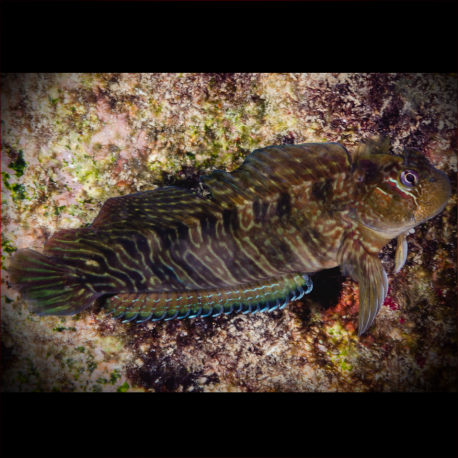More info
Datasheet
| Minimum Tank Size | 400 litres / 105.67 US gallons |
| Maximum Size | 16.0cm / 6.30inches |
| Reef Compatible | Often reef safe |
| Temperament | Might be aggressive towards food competitors |
| Temperature | 22.2°C / 71.96°F - 25.6°C / 78.08°F |
| Specific Gravity | 1.020-1.025 |
| Carbonate Hardness | 8-12 |
| pH | 8.1-8.4 |
General Description
The Rippled Rockskipper, scientifically known as Istiblennius edentulus, belongs to the family Blenniidae. These fish are characterized by their oblong shape, long dorsal fin, and typically small size, making them suitable for both small and large aquarium setups. While not particularly colorful, they are noted for their engaging personalities, which appeal to many aquarists.
Aquarium Suitability
Rippled Rockskippers are considered suitable for aquariums with proper care. They are effective algae-eaters, primarily consuming algae from rocks and glass. While they can be trained to accept dry foods, it is not something that can be reliably counted on. These fish do best in a tank with a minimum size of 400 liters and are known to be territorial, thriving better when kept alone without other members of the same species.
Demands, Care, and Hardiness
With a hardy nature, Rippled Rockskippers require water temperatures between 22.2-25.6 degrees Celsius, a pH range of 8.1-8.4, and a specific gravity of 1.020-1.025. They can be aggressive towards food competitors and are known to jump out of open aquariums, so precautions should be taken to secure the tank appropriately.
Reef Suitability
When well-fed, Rippled Rockskippers are generally reef-safe; however, they may nibble on soft coral and LPS if food is scarce. They are often compatible with reef environments, but their behavior towards other tank inhabitants should be monitored closely.
Aquarium Setup
For the optimal setup of an aquarium housing Rippled Rockskippers, it is important to ensure the presence of sufficient algae growth on rocks and glass to serve as their primary food source. Providing hiding spots and territories within the tank can help mitigate territorial aggression. Care should be taken to secure the tank to prevent these fish from jumping out.
Behaviour
These fish exhibit territorial behavior and may display aggression towards other tank mates, especially when it comes to competition for food. They are known to be lively and interactive within their environment, showcasing individual personalities that make them captivating to observe.
Feeding and Diet
Rippled Rockskippers predominantly feed on algae, particularly macroalgae like seaweed and nori. While they can consume various types of algae, it is essential to ensure a diverse diet that includes microalgae such as spirulina to meet their nutritional requirements adequately.
Dimorphism
Information on dimorphism for Rippled Rockskippers is not provided.
Habitat and Distribution
These fish are native to the Indo-Pacific region, ranging from the Red Sea and East Africa to the Line, Marquesan, and Tuamoto islands. They can be found as far north as southern Japan and as far south as Lord Howe and Rapa. In their natural habitat, Rippled Rockskippers inhabit rocky areas with ample algae growth, which serves as their primary source of food.

